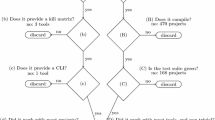Abstract
The computation of ripple effect is based on the effect that a change to a single variable will have on the rest of a program; it determines the scope of the change and provides a measure of the program’s complexity. The original algorithm used to compute ripple effect has been reformulated mainly to provide clarity in the operations involved. The reformulation involved some approximation which was shown not to affect the measures produced. The reformulated, approximated algorithm has been implemented as the software tool: Ripple Effect and Stability Tool (REST). This paper uses a software development project as a case study to look at the relationship between the approximated ripple effect and a programmer’s intuitive idea of ripple effect. Four versions of a mutation testing software tool were written in C over a period of several months. After the completion of each version the programmer was asked to detail his predicted/intuitive ripple effect for each module of code. The predictions are compared with the approximated ripple effect measures for each module and some surprising conclusions drawn.
Similar content being viewed by others
References
AlSharif M, Bond WP, Al-Otaiby T (2004) Assessing the complexity of software architecture. In: Proceedings of the 42nd annual Southeast regional conference. ACM Press, New York, pp 98–103. DOI http://doi.acm.org/10.1145/986537.986562
Bainbridge JR (1993) A probablistic method for software product measurement. Ph.D. thesis, SCISM, South Bank University, London, p 149
Bainbridge JR, Whitty RW (2000) An empirical investigation into fault coupling in finite functions. Final report to the EPSRC on Grant gr/K85025
Baker A, Bieman J, Fenton N, Gustavson D, Melton A, Whitty R (1990) A philosophy for software measurement. J Syst Softw 12(3):277–281
Basili VR, Hutchens DH (1983b) An empirical study of a syntactic complexity family. IEEE Trans Softw Eng 9(6):664–672
Black SE (2001a) Automating ripple effect measurement. In: 5th world multi-conference on systemics, cybernetics and informatics
Black SE (2001b) Computation of ripple effects for software. Ph.D. thesis, School of Computing, Information Systems and Mathematics, South Bank University, London, p 124
Black SE (2001c) Computing ripple effect for software maintenance. Softw Maint Res Pract 13(4)
Bowen JB (1978) Are current approaches sufficient for measuring software quality? In: Proceedings of the software quality assurance workshop, pp 148–155
Fenton N, Pfleeger SL (1996) Software metrics: a rigorous and practical approach. Chapman and Hall, London
Glass RL (2002) Sorting out software complexity. Commun ACM 45(11):19–21, DOI http://doi.acm.org/10.1145/ 581571.581584
Halstead MH (1977) Elements of software science. Elsevier, New York
Haney FM (1972) Module connection analysis-a tool for scheduling of software debugging activities. In: Proceedings of the fall joint computer conference, pp 173–179
McCabe TJ (1976) A complexity measure. IEEE Trans Softw Eng 2(4):308–320
Myers GJ (1980) A model of program stability. Van Nostrand Reinhold, New York, pp 137–155
Park E Robert (1992) Software size measurement: a framework for counting source statements. Software Engineering Institute
Shepperd M (1993) Software engineering metrics volume I: measures and validations. McGraw-Hill, London
Soong NL (1977) A program stability measure. In: Proceedings of the 1977 annual ACM conference, pp 163–173
Yau SS, Collofello JS (1980) Some stability measures for software maintenance. IEEE Trans Softw Eng SE 6(6):545–552
Yau SS, Collofello JS (1985) Design stability measures for software maintenance. IEEE Trans Softw Eng SE 11(9):849–856
Yau SS, Collofello JS, McGregor TM (1978) Ripple effect analysis of software maintenance. In: Proceedings of COMPSAC ’78, pp 60–65
Author information
Authors and Affiliations
Corresponding author
Rights and permissions
About this article
Cite this article
Black, S. Is ripple effect intuitive? A pilot study. Innovations Syst Softw Eng 2, 88–98 (2006). https://doi.org/10.1007/s11334-006-0004-x
Received:
Accepted:
Published:
Issue Date:
DOI: https://doi.org/10.1007/s11334-006-0004-x




